Howdy, Peep here. Recently my Markeroon melydia and I took a trip to central Illinois. (She calls me her mascot, but I’m the real brains in this outfit.) She was muttering something about visiting her parents or some such, but I know she really wanted to go so she could take pictures of me posing with historical markers. I overheard her telling her parents about a few signs she knew about, and they decided to take a little tour around town.
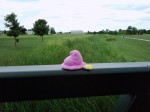
Me by the cattails
We started by Parkland College, where we saw the Champaign County Worker’s Memorial and the Tribute to Olympic Athletes. (One wonders why the apostrophe is so positioned, since they are presumably honoring multiple workers, but hey, whatever. I’m just the talent.) The weather was gorgeous, and mely couldn’t resist taking a photo of me by the bed of cattails creek.
From there we struck out into the unknown. Though melydia only knew of one other marker in particular, her dad was surprisingly enthusiastic and came up with several possible spots to check. The first was the oldest bridge in Champaign

Old Bridge
County, which unfortunately was missing its sign. It also seemed to be undergoing some construction. We found some rope, a computer speaker, and some car keys near by. Dad figured the rope could come in handy and Mom took the keys to return them to their owner (they had grocery store cards attached), but we left the speaker. I could have used it for my secret mascot rave parties, but melydia would hear none of it.
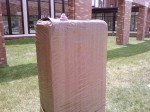
Me on the covered marker
The one other marker melydia knew of in the area was by the county court house, which has evidently been undergoing construction for some time. We found the marker, but it was all covered up. Here’s a photo of me as proof of our visit; melydia’s parents said they would return later, after the construction was finished, to take a picture. We then planned to hit campus, but first Dad suggested we first stop by the Urbana Free Library. The plaque was too small to accommodate me, and melydia’s husband somehow managed to “forget” me when taking a picture of a beautiful new statue called “Slow and Steady”. Hmmph.

Slow and Steady
Campus was a wealth of markers. We started at the Hallene Gateway, which is basically the doorway of old University Hall, which burned down or something in 1938. Evidently this part of the building was found in some basement somewhere

Hallene Gateway
and they decided to make a monument out of it. It was a good thing mely had the good sense to bring her parents, because she never would have thought to visit this gateway. Or the Morrow Plots, which is where we stopped next. The Morrow Plots are the country’s oldest experimental field, established in 1876. It had been plowed so many times the plants were growing in a little ravine.
From there we wandered around, looking for more markers. The University of Illinois had recently installed a number of markers to honor various scientific breakthroughs over the years. Melydia tried to obtain a listing, but it was unavailable due to the amount of vandalism. I don’t get that, personally. Street signs are one thing – they’re everywhere and relatively inexpensive to replace. But these are one-of-a-kind memorials. And more importantly, if there’s no marker, there’s nowhere for me to pose!
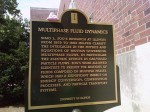
Multiphase Fluid Zzzzzz...
But it turned out not to matter much, as the markers were everywhere. Remember what I said about scientific breakthroughs? Yeah, it was Nerdtopia. Nerdvana, if you will. I fell asleep just reading the title of “Multiphase Fluid Dynamics,” but melydia seemed to know what it was talking about. (Nerd.) Thank goodness we stopped for ice cream after that, so I could take a rest from all this modeling. Being gorgeous can really work up an appetite. Melydia wouldn’t share, though. Something about “not having a mouth.” Whatever. She was just being selfish.
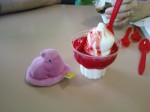
No ice cream for me!
The family was getting pretty tuckered out by that point, so after a couple more snarfs on campus, we stopped by the Cattle Bank (also known as the oldest building in town) and the New Orpheum Theatre (now a children’s museum). One of the
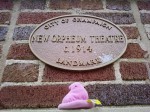
City of Champaign Landmark?
signs on the Orpheum designated it as a “City of Champaign Landmark.” Melydia was curious if there was a list of these local landmarks, but her parents and husband were tired, and since Dad was driving, they went straight home.
I thought we were done with landmarks for the trip, and I would be stuffed in melydia’s purse for the rest of the visit, but I was wrong. Dad had one more marker up his sleeve. A couple days later, we drove out to a cornfield near the tiny village of Bellflower to see a bit of glacier rock (that is, a rock shaped by a glacier) memorializing the generous donation of the Flanigons to the Bellflower schools. After a quick trip through the long-closed Chanute Air Force Base for a quick peek at the old planes, we stopped at Hickory River for some
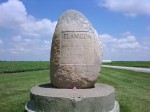
Bonus snarf!
delicious barbecue. (At least I assume it was delicious. Once again, melydia wouldn’t let me have any. Oh well, I guess all great models have to watch their figures.)
So that was my trip to the midwest. I guess there was some other stuff too, like fireworks and s’mores and puzzles and stuff, but I was stuck in the purse for all that. This was just the important bits.








